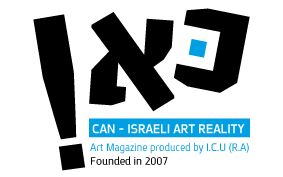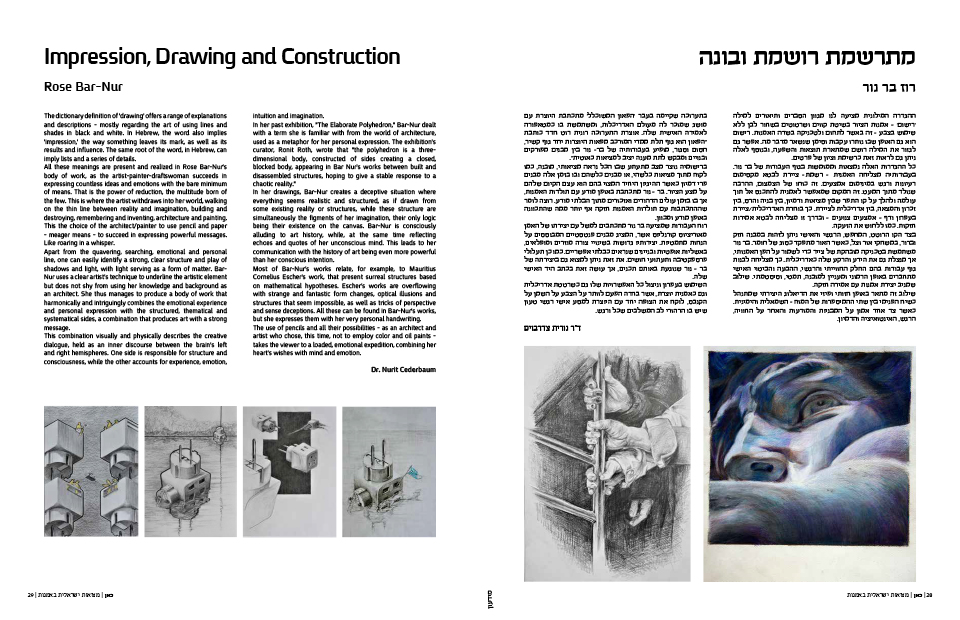
| Home Page | Editor Notices | Museums | Galleries | Publication | Donation | Contact Us |


 | |||||||||||||||
| |||||||||||||||


| |||||||||||||||
| Rose Bar-Nur |
The dictionary definition of 'drawing' offers a range of explanations and descriptions – mostly regarding the art of using lines and shades in black and white. In Hebrew, the word also implies 'impression,' the way something leaves its mark, as well as its results and influence. The same root of the word, in Hebrew, can imply lists and a series of details. All these meanings are present and realized in Rose Bar-Nur's body of work, as the artist-painter-draftswoman succeeds in expressing countless ideas and emotions with the bare minimum of means. That is the power of reduction, the multitude born of the few. This is where the artist withdraws into her world, walking on the thin line between reality and imagination, building and destroying, remembering and inventing, architecture and painting. This the choice of the architect/painter to use pencil and paper – meager means – to succeed in expressing powerful messages. Like roaring in a whisper. Apart from the quavering, searching, emotional and personal line, one can easily identify a strong, clear structure and play of shadows and light, with light serving as a form of matter. Bar-Nur uses a clear artist's technique to underline the artistic element but does not shy from using her knowledge and background as an architect. She thus manages to produce a body of work that harmonically and intriguingly combines the emotional experience and personal expression with the structured, thematical and systematical sides, a combination that produces art with a strong message. This combination visually and physically describes the creative dialogue, held as an inner discourse between the brain's left and right hemispheres. One side is responsible for structure and consciousness, while the other accounts for experience, emotion, intuition and imagination. In her past exhibition, "The Elaborate Polyhedron," Bar-Nur dealt with a term she is familiar with from the world of architecture, used as a metaphor for her personal expression. The exhibition's curator, Ronit Roth, wrote that "the polyhedron is a three-dimensional body, constructed of sides creating a closed, blocked body, appearing in Bar Nur's works between built and disassembled structures, hoping to give a stable response to a chaotic reality." In her drawings, Bar-Nur creates a deceptive situation where everything seems realistic and structured, as if drawn from some existing reality or structures, while these structure are simultaneously the figments of her imagination, their only logic being their existence on the canvas. Bar-Nur is consciously alluding to art history, while, at the same time reflecting echoes and quotes of her unconscious mind. This leads to her communication with the history of art being even more powerful than her conscious intention. Most of Bar-Nur's works relate, for example, to Mauritius Cornelius Escher's work, that present surreal structures based on mathematical hypotheses. Escher's works are overflowing with strange and fantastic form changes, optical illusions and structures that seem impossible, as well as tricks of perspective and sense deceptions. All these can be found in Bar-Nur's works, but she expresses them with her very personal handwriting. The use of pencils and all their possibilities – as an architect and artist who chose, this time, not to employ color and oil paints – takes the viewer to a loaded, emotional expedition, combining her heart's wishes with mind and emotion. Dr. Nurit Cederbaum Read more  |
| all rights reserved - CAN ISRAELI ART REALITY |
| סייבורג מחשבים - בניית אתרים |